An article, published in The Lancet eClinical Medicine and promoted by the University of Paris Saclay, aims to prevent the collapse of neonatal intensive care units and protect the most vulnerable children from a potentially fatal infection.
UniCamillus, represented by Maria Rosaria Gualano, Associate Professor of General and Applied Hygiene, made a decisive contribution to the development of the world’s first protocol for the management of neonates suffering from bronchiolitis in intensive care units.
The study, published in The Lancet eClinical Medicine, has proved to be a turning point in keeping under control a condition that kills hundreds of thousands of children every year.
Bronchiolitis is a serious respiratory infection which mainly affects babies and young children. In the most severe cases, it can be fatal, leading to critical respiratory failure.
Caused mainly by the respiratory syncytial virus (RSV), bronchiolitis is a highly contagious seasonal disease which can result in several admissions to paediatric and neonatal intensive care units in both Europe and North America due to the cold season and contagiousness in kindergartens.
Despite the aggressiveness and danger of this disease, the existing scientific literature is mainly based on protocols studied in patients admitted to general paediatric wards: this does not help to deal with the emergencies caused by epidemics and the most severe cases requiring intensive care hospitalisation.
In this context, the work promoted by Professor Daniele De Luca, Professor of Neonatology at the University of Paris Saclay, together with other researchers and experts from various Italian and French universities, including Professor Gualano, who played an important coordinating role and provided organisational and executive leadership, proved to be crucial.
The first protocol for managing the most critical cases
The objectives of these guidelines are: to prepare hospital teams to recognise the most severe cases for transfer to emergency departments; to identify criteria for diagnosing different levels of severity in paediatric patients; to manage patients using different and appropriate methods of nutrition, hydration, supplementation and pharmacological therapy, trying to avoid intubation of young patients and advanced non-invasive respiratory support; to ensure better control of the spread of the virus through appropriate personal protective equipment, secure ways of isolation, filters and specific techniques.
All of this is aimed at preventing the collapse of intensive care units and protecting neonates in more vulnerable situations (for example, those who are very small, with weaker immune systems and/or pre-existing comorbidities).
A long-awaited study by the scientific community
This study was eagerly awaited by the scientific community, given the urgency of developing a strategy to deal with such a complex and delicate situation, as well as considering the worrying epidemiological picture of bronchiolitis in Italy and Europe.
“The protocol proposed by our study will be crucial for the management of small patients with frailty, who are more severe and complex cases to treat than other patients”, comments Professor Gualano. “By combining research based on the best reference studies with data from our daily reality, we have been able to reach this important milestone, from which we expect excellent results both in terms of improving clinical outcomes and economically, given the good cost-effectiveness of this approach”.
In addition to the University of Paris Saclay and to UniCamillus University in Rome, the study involved the paediatric intensive care units of the Bambino Gesù in Rome and the University Hospital of Padua, as well as the Gemelli Policlinico Foundation in Rome and the Centre for Research and Studies on Leadership of the Università Cattolica del Sacro Cuore in Rome.
The study can be read about on the The Lancet eClinical Medicine website.

